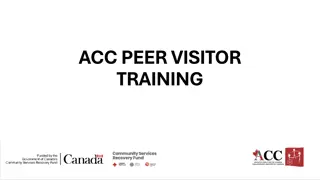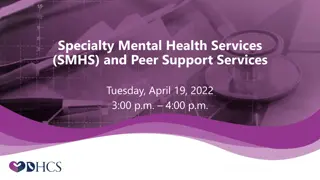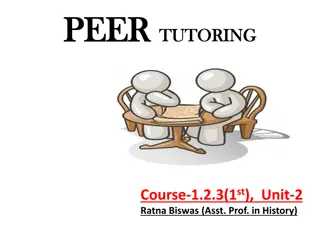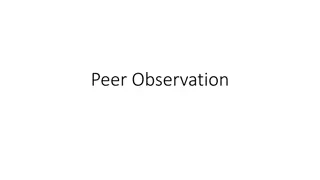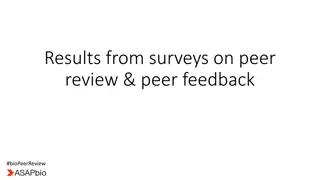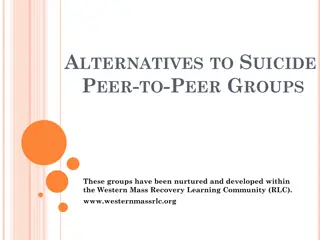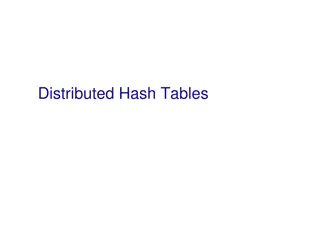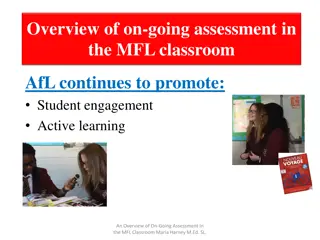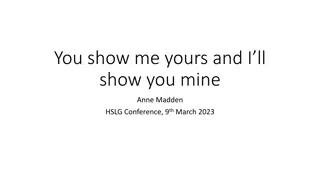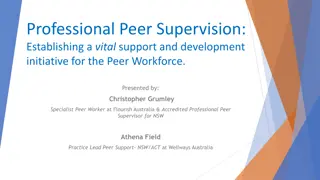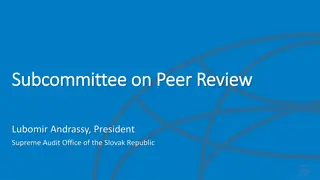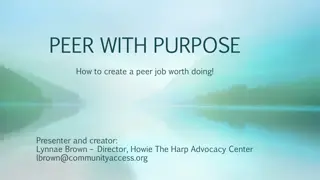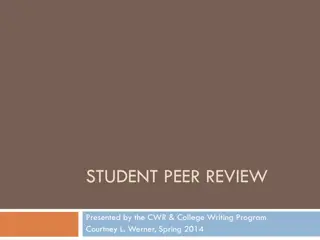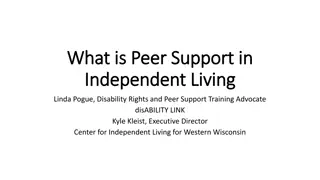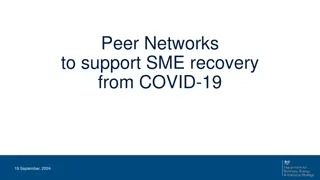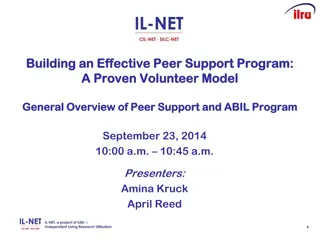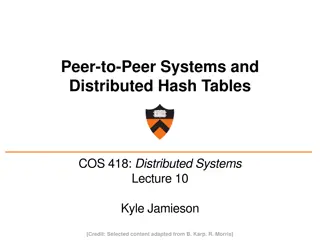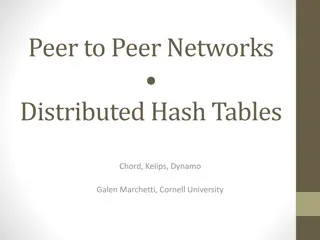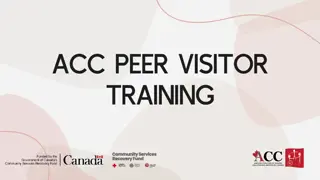Peer Engagement in Assessment: Key Concepts and Practices
Explore the significance of peer engagement in assessment, including defining peer engagement, the role of students in learning, designing feedback opportunities, and supporting self-regulatory skills. Learn about different interpretations of peer feedback and what we know about its effectiveness in student learning.
Download Presentation

Please find below an Image/Link to download the presentation.
The content on the website is provided AS IS for your information and personal use only. It may not be sold, licensed, or shared on other websites without obtaining consent from the author. Download presentation by click this link. If you encounter any issues during the download, it is possible that the publisher has removed the file from their server.
E N D
Presentation Transcript
Peer Engagement in Assessment Carol Evans and Laura Grange L.J.Grange@noc.soton.ac.uk c.a.evans@soton.ac.uk NOCs 10 March, 2016 Seminar room 104/13
Key Questions How do we define peer engagement? What is the role of the student in the learning process? How can we design peer feedback opportunities in order to support student learning as well as minimise potential constraints on learning? Can peer engagement activities support the development of student self-regulatory skills?
Rationale Unless students are enabled, through the design of the learning environment, to develop appropriate expertise themselves, they cannot self-monitor and thereby control the quality of their own work.... Sadler (2005, 192)
Defining Engagement in learning: Continuums: What Pedagogy? Active v Passive judgements Continuous selected attention Compliance developing rules Holistic involvement parachutist Immediate ................ longer term learning outcomes Inward focus ..................outward focus Own development ..development of others Using resources creating resources Making use of knowledge .creating knowledge Reflective Transformative Student Ownership?
Different interpretations of Peer Feedback 1. Formative and/or summative. 2. A stand-alone vs a one off element or an integrated aspect of learning and teaching design. 3. A compulsory vs choice element of assessment. 4. Focused on peer-to-peer feedback and/or group feedback. 5. Focused on student feedback giving and/or on student response to feedback. 6. Student controlling the feedback process to manage sources of feedback and/or student as a passive receiver of feedback.
What do we know about Peer Feedback? 1. For accuracy: multiple peer markers are preferred over single markers (Bouzidi & Jaillet, 2009). 2. Peer assessment is most effective when included as an element within a holistic assessment design (Nicol & MacFarlane Dick, 2006). 3. Peer feedback can be a positive experience for many students but not for all (Fund, 2010). 4. The nature of the implementation and roles of assessor and assessee influence outcomes (Gielen et al., 2011). 5. Receiving feedback has less impact on future performance than giving feedback (Kim, 2009).
What do we know about Peer Feedback? 6. The academic ability of the feedback giver and recipient is important (Van Zundert et al., 2010). 7. The affective dimension is very important, as is the provision of choice most recommend the formative use of peer assessment rather than summative (Nicol, 2008). 8. The nature and type of feedback peers are asked to give impacts on performance (Tseng & Tsai, 2010). 9. The importance of training students / lecturers in how to give feedback (Sluijsmans, Brand-Gruwel, & Van Merrienboer, 2002).
Using a PLSP to support peer engagement Explicit discussion of experiences of peer feedback & assessment. Clarification of the peer element within the learning process and agreement of student roles within this. Clarification of what is good use of assessment criteria to critique examplars of work. A. Exploration of student and lecturer beliefs B. An appreciation of the fact that learners have different needs. Student mapping of support networks and individual needs analysis metacognitive mapping of strengths and areas for development - how to access info & support development of rubrics to support self-assessment. Exposure to different peer feedback models emphasis placed on how students use feedback; and feedback they give on feedback; developing feedback seeking skills. C. It is research informed and considers feedback, feedforward and feed up. D. Promotes student and lecturer agency Students feedback seeking and using skills assessed as part of summative assessment. Student in driving seat in managing feedback received. Attention focused on emotional regulation strategies Peer engagement activities = integral element of curriculum. E. Assessment feedback is seen as an integral part of learning and teaching
Main Findings Peer feedback seen as most valuable in providing emotional support for some but also taxing for others. Peer feedback seen as important in supporting self development but not for all. PLSP approach valuable in framing peer feedback interventions Who manages the peer feedback process is important. Issues of trust (of self and others). Competence issue: Perceptions of ability in being able to give and receive feedback. Personal histories of peer feedback / lack of experience framed receptivity to the process. Perception of value in relation to other sources of support and fit with existing schema. Immersion in peer feedback process can be useful. Networks: strong or impoverished: need to be shown how to access.
What did students value? Opportunity to explicitly discuss their own beliefs and values. The opportunity to explore individual differences within groups (Trahar, 2007, & Tweed & Lehman, 2002). Being able to use specific tools to consider the learning process. Agency: Individuals in driving seat managing engagement. The benefits of having to re-explain their own work to different audiences opportunities to work with different groups. The benefits of progressive peer feedback involving the integration of feedback from peers on an individual and group basis. Addressing perceptions of power in learning. Addressing responsibility for feedback.
Questions 1. Worthwhile or a waste of time? What is the value? Where appropriate? 2. How best to incorporate peer engagement into learning and teaching design. How are you using this in your own practice? 3. How are students prepared to give, seek, and act on peer feedback? 4. To what extent should students be able to opt out of peer engagement activities and/ or be given a choice in the nature and level of involvement in such activities? 5. How is students engagement in peer activity being assessed? 6. Can peer engagement activities support the development of student self- regulatory skills?
Making the Peer Feedback Process explicit Clarifying why the process is important relevance /authenticity. Exploring beliefs and values of students. Clarifying what is negotiable and what is not. Clarifying the aspects of feedback students are to work on. Clarifying what is good explicit working with assessment criteria. Use of specific tools to support understanding. Ensuring students give feedback on feedback. Student feedback giving ability and self assessment of such as part of summative assessment. Clarify roles student in charge of peer assessment process.
Recommendations Whilst much is written about the benefits of group work and peer feedback in facilitating self-understanding and self-regulation in learning (Bartram 2008), tackling students perceptions of this and giving guided support in how students can work to support each other from the outset is important. This includes: explicit discussion regarding the boundaries in the giving of feedback (content; process; ethics etc). When students are given experience of different study approaches, they are able to draw conclusions about what works best for them providing an approach to developing the self-regulation loop (Evans & Waring, 2011). The issue is one of ensuring authentic experiences and negotiating choice and ensuring students have a clear understanding of what is good in assessment terms, what good feedback practice is and why the process is valuable to them.



